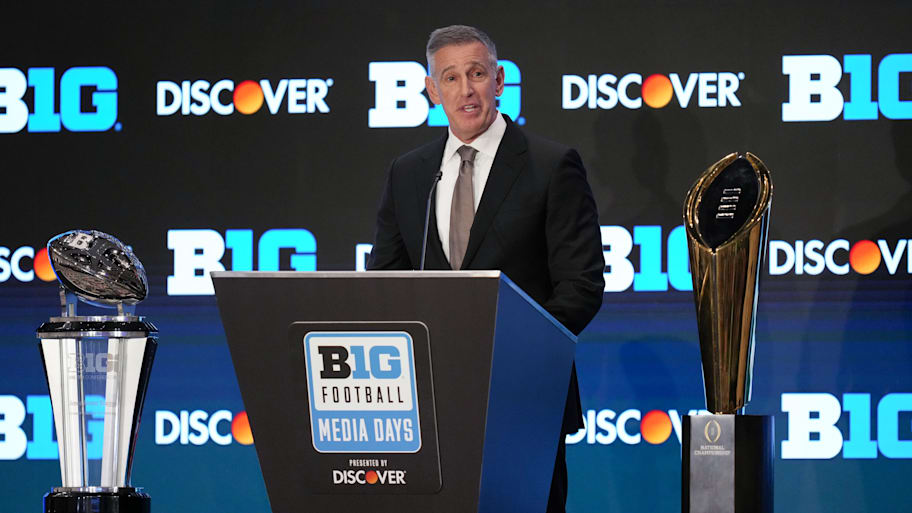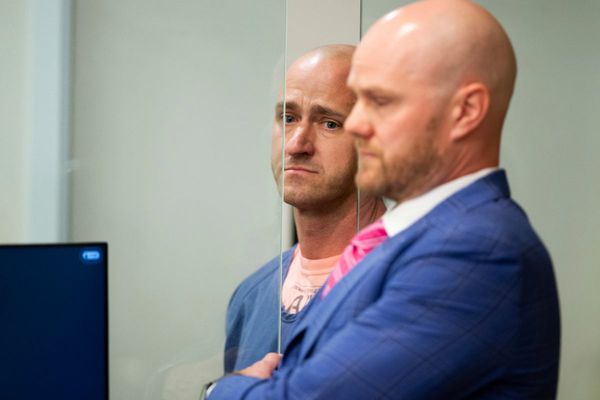
The Big Ten Conference already is the clearly established industry leader in bad ideas. It might have another one coming down the pike now in the form of a private capital arrangement.
The nation’s wealthiest athletic conference, which has been trying its hardest to junk up the College Football Playoff with one dubious (and self-serving) expansion concept after another, has a different get-rich(er)-quick plan in the works. ESPN reported Wednesday that the Big Ten is discussing a private capital deal that could add $2 billion or more to the league and its 18 member schools.
Commissioner Tony Petitti, who has yet to find an element of college athletics that he wouldn’t like to turn into a cash grab, is spearheading discussions with three private capital firms.
Among the intriguing elements to this potential deal: a proposed 10-year extension of the league’s grant-of-rights agreements through 2046; and what ESPN termed a “tiered distribution” of the new revenue. Those two dynamics would seemingly work at cross purposes—binding the league together longer while further separating the top brands from the rest. While the grant-of-rights extension that far into the future might stave off creation of a long-theorized Super League, it could still further reduce the number of schools capable of competing for national championships in revenue sports.
The conference has been discussing various iterations of this plan for months, multiple industry sources tell Sports Illustrated, with some saying they believed the concept was running out of steam as time dragged on. At the very least, there is no unanimity within the Big Ten at the moment, sources say, with schools having varying views of whether this is a prudent approach to additional revenue generation.
As ESPN noted, most of the conference is believed to support the idea. But that doesn’t include the biggest dogs—Ohio State and Michigan are still talking it through with the conference, among others. At least one Michigan regent publicly voiced his resistance Wednesday.
“As a Regent, I believe selling off Michigan’s precious public university assets would betray our responsibility to students and taxpayers,” Jordan Acker posted on X. “I will firmly oppose any such effort—and I hope colleagues at [Michigan State] and Ohio State will stand with me as well.”
As a Regent, I believe selling off Michigan’s precious public university assets would betray our responsibility to students and taxpayers. I will firmly oppose any such effort—and I hope colleagues at @MSU and @OhioState will stand with me as well. https://t.co/gd2rQ7na6u
— Jordan Acker (@JordanAckerMI) October 1, 2025
This could very well be where “tiered distribution” comes into play. To get Michigan and Ohio State (and perhaps others) to play ball here, the Big Ten may cut the pie into unequal slices. The Wolverines and the Buckeyes would get more than, say, Rutgers and Maryland. Accommodations might have to be made.
Uneven revenue has never been good for the overall health of a conference—Texas’s advantageous media-rights deals fractured the Big 12, and the Florida State/Clemson lawsuits against the ACC are leading to uneven payouts there. But perhaps it’s inevitable, as the concept of equal partnerships among like-minded universities grows quaint and musty. Is there really much like-minded about Stanford and Louisville in the ACC, or Nebraska and USC in the Big Ten?
The entirety of college sports is a leverage play now, as the professionalization of it takes hold.
An infusion of private capital that could immediately put $100 million or more in the athletic coffers of each Big Ten school is an intoxicating idea. It’s likely especially attractive to those members in the lower two-thirds of the league’s food chain. Schools are paying $20.5 million this year in House v. NCAA settlement costs to athletes, while many of them also are dealing with huge debt-servicing costs for an array of facilities improvements.
But there is no such thing as free money, and private capital comes with a cost. If a private equity firm can create a win-win scenario where it invests, fine. But if not, it will create a win for itself first and foremost.
Even if the league succeeds in crafting an arrangement that does not cede any of its major functions to an outside firm, the new partner in “Big Ten Enterprises” would theoretically have a lot to say about how business is done.
The conference already has one very influential, hands-on partner in that regard in Fox. (Don’t think the network wasn’t fully involved in the expansion decisions that destroyed the Pac-12.) If the next partner wants to tell Big Ten members what has to change in order to make more money, there are a couple billion reasons why everyone would have to go along with it.
Southeastern Conference commissioner Greg Sankey has been publicly wary of private equity/capital for quite a while. The Big 12 looked into it at the behest of commissioner Brett Yormark, but too many league members balked at the concept. On the campus level, Florida State’s interest in a private equity arrangement has cooled.

Still, many in the college sports space believe the arrival of private equity/capital is inevitable and actually sensible. One of the draws for those firms are inefficient markets, and a lot of people are certain that college sports is leaving a ton of money on the table at a time when it needs the funds.
“There are probably more answers or more strategies than a lot of people are willing to actually use,” says Jake Rosenberg of The Athlete Group, which is partly a boutique search firm and partly a consulting business that can help athletic departments make more and spend less. “People just want to chalk everything up to mass chaos and put their head between their own knees and assume crash position. I think our premise business-wise is that there actually are still a lot of ways to be smarter and be more strategic, and then you get paid back disproportionately because things are so inefficient.
“There’s so much change in college, I think we have the best chance to understand what these roles should look like because we’re doing actually the work and we’re on the ground. And I think those of us that have experience in professional ranks doesn’t translate exactly, but there are a lot of qualities about professional sports that are more of a part of college sports now.”
In the case of the Big Ten, which already has the biggest media-rights revenue oil gusher of them all, this feels like another Everything Is For Sale sign on the office’s front door. Does it really need to be? Or are there ways for each individual university to make decisions on their finances that align with what they stand for?
When the facilities arms race met up with the House settlement, the wanton economics of college sports reached its ultimate stress test. Trev Alberts, former athletic director at Nebraska and now at Texas A&M, might have characterized the situation best: “We don’t have a revenue problem. We have a spending problem.”
Borrowing billions of dollars doesn’t seem like the best way to fix a spending problem.
More College Football on Sports Illustrated
Listen to SI’s new college sports podcast, Others Receiving Votes, below or on Apple and Spotify. Watch the show on SI’s YouTube channel.
This article was originally published on www.si.com as Big Ten’s Latest Bad Idea: Selling Its Future for Private Capital.







